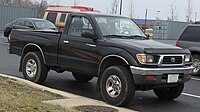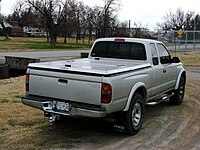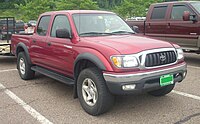
A | B | C | D | E | F | G | H | CH | I | J | K | L | M | N | O | P | Q | R | S | T | U | V | W | X | Y | Z | 0 | 1 | 2 | 3 | 4 | 5 | 6 | 7 | 8 | 9
| Toyota Tacoma | |
|---|---|
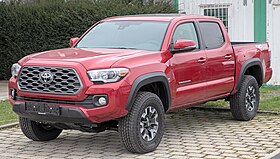 2020 Toyota Tacoma TRD Off-Road | |
| Overview | |
| Manufacturer | Toyota |
| Production | January 1995 – present |
| Model years | 1995–present |
| Body and chassis | |
| Class |
|
| Layout | Front-engine, rear-wheel drive/four-wheel drive |
| Chronology | |
| Predecessor | Toyota Pickup (1995) |
The Toyota Tacoma is a pickup truck manufactured by Japanese automobile manufacturer Toyota since 1995. The first-generation Tacoma (model years 1995 through 2004) was classified as a compact pickup. The second generation (model years 2005 through 2015) and third generation (in production since 2015) models are classified as mid-sized pickups. The Tacoma was Motor Trend's Truck of the Year for 2005.
As of 2015, the Tacoma was sold in the United States, Canada, Mexico, Costa Rica,[1] Bolivia, Bermuda, and the French overseas collectivity of New Caledonia. Most markets across the world receive the Toyota Hilux in lieu of the Tacoma.
The name "Tacoma" was derived from the Coast Salish peoples' name for Mount Rainier in the U.S. state of Washington.[2]
First generation (N140/N150/N160/N170/N190; 1995)
| First generation | |
|---|---|
 | |
| Overview | |
| Model code |
|
| Production | January 1995 — August 2004 |
| Model years | 1995–2004 |
| Assembly | United States: Fremont, California (NUMMI) |
| Designer |
|
| Body and chassis | |
| Body style |
|
| Related | |
| Powertrain | |
| Engine | |
| Transmission | |
| Dimensions | |
| Wheelbase |
|
| Length | 174.8–203.1 in (4,440–5,159 mm) |
| Width |
|
| Height |
|
| Curb weight |
|
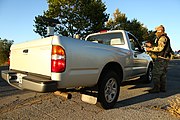
The Tacoma was introduced in the US in February 1995 (with a market launch in March 1995) as a replacement for the Toyota Pickup (which was the name used for the Hilux in the North American market). When comparing with the Hilux, the Tacoma receives engineering with greater priority on ride quality, handling, comfort, and safety over ruggedness and payload capacity. The design intends to better suit the needs of the US and Canadian market, where pickup trucks are used as personal vehicles rather than for commercial, agricultural, and off-road purposes.
Development
Development began in 1989, following the launch of the fifth-generation Toyota Pickup in late 1988 and concluded in 1994. Design work was done at Calty Design Research in California from 1990 to 1992, when Kevin Hunter's exterior design proposal was chosen in the autumn of 1991 and in final form, frozen for production in 1992. Patents for the production design were filed in Japan in April 1993 and October 28, 1993, in the United States.[4][5]
Technical
Three engines were available for the Tacoma:
| Engine | Model | Type | Power | Torque | 2WD | 4WD | Consumption[6] |
|---|---|---|---|---|---|---|---|
| 2.4 L | 2RZ-FE | I4 | 142 hp 144 PS; 106 kW |
160 lb⋅ft 217 N⋅m |
26 mpg‑US 9.0 L/100 km[a] | ||
| 2.7 L | 3RZ-FE | I4 | 150 hp 152 PS; 112 kW |
177 lb⋅ft 240 N⋅m |
20 mpg‑US 12 L/100 km; 24 mpg‑imp[b] | ||
| 3.4 L | 5VZ-FE | V6 | 190 hp 193 PS; 142 kW |
220 lb⋅ft 298 N⋅m |
21 mpg‑US 11 L/100 km; 25 mpg‑imp[a] |
- Notes

Two-wheel drive (2WD) Tacomas (excluding PreRunner models) had five-stud wheel-lug patterns and either the 2.4- or 3.4-liter engine. Four-wheel drive (4WD) and PreRunner Tacomas had six-stud wheel-lug patterns and were available with either the 2.7-L or 3.4-L engine. Initially, the 2.4 L was limited to the 2WD models (both regular and Xtracab), while the 2.7-liter the standard engine for 4WD models, and the 3.4-liter V6, shared with the larger T100 truck,[7] was an option for the 2WD (Xtracab only) and 4WD (regular and Xtracab).[8] The top-of-the-line SR5 trim was available for the 4WD Xtracab V6.[9] From 1997 on, the 3.4 L V6 was dropped as an option for the regular cab models, which were available only with a 2.4-L or a 2.7-L four-cylinder engine.
An aftermarket Toyota Racing Development (TRD) supercharger kit was available for the 3.4-liter V6, raising output to 254 hp (258 PS; 189 kW) and 270 lb⋅ft (366 N⋅m).[10] The V6 supercharger kit was specified for model years 1997 and later,[11] as the earlier engine control units (ECUs) had limitations.[12] A kit to add a 7th fuel injector was available, including a replacement ECU, boosting performance further to 262 hp (195 kW) and 279 lb⋅ft (378 N⋅m).[13] In addition, TRD supercharger kits were available for the 4-cylinder engines (2.4 L and 2.7 L) as well.[14][15]
A five-speed manual transmission was standard for all models initially, with a four-speed automatic transmission available as an option except for the 4WD V6 regular cab.[8] The PreRunner (MY98–04) and Double Cab (01–04) models were available only with an automatic transmission for the first generation.[16] The 3.4 L V6 was paired with the R150F manual transmission or the A340F (4WD) or A340E (2WD) Aisin automatic transmission; the A340F code is 30-40LE.
The first-generation Tacoma has a fully-boxed frame (meaning the main frame rails have a closed rectangular cross-section)[17] until immediately after the rear leaf spring mounting bracket, where the frame transitions into a C-shaped cross-section. The TRD Off-Road package was introduced in 1998. This package added a locking rear differential and was only available to PreRunner and four-wheel drive models that were equipped with the 3.4-L V6. Antilock brakes were made standard across the Tacoma line for the 2003 model year.[7]
Updates
The first-generation Tacoma underwent its first minor update in October 1996, switching from recessed sealed beam headlamps to a flush design on 2WD models. There were two more cosmetic facelifts: the first in July 1997 and the second in October 2000. The most visible changes were in the modified front grilles (both facelifts, for model years 1998 and 2001) and tailgate badging and emblems (first facelift, MY1998). The MY1998 facelift included distinct grilles for the 2WD and 4WD models; 2WD models featured a prominent horizontal bar splitting the grille.[18] A StepSide bed was added as an option for MY2000.[7]
-
1995–1997 Tacoma Xtracab 2WD
(sealed beam headlamps) -
1995–1997 Tacoma 4WD
(sealed beam headlamps) -
1998–2000 Tacoma Xtracab 2WD
(flush headlamps, first updated grille) -
1998–2000 Tacoma Xtracab 4WD
(flush headlamps, first updated grille) -
2001–2004 Tacoma Regular Cab
(second updated grille, textured tail light lenses) -
1995–1997 Tacoma rear
(large, centered "TOYOTA" on tailgate) -
1998–2000 Tacoma rear
(small "TOYOTA" in upper left corner with smooth tail light lenses)
Variants
At its introduction as a model year 19951⁄2, Tacoma 4WD and 2WD models could be distinguished externally by the front grilles. The 4WD model had two heavy chrome bars flanking a trapezoidal opening, tapering toward the top, while the 2WD model had thinner bars (optionally chrome) with a trapezoidal shape tapering toward the bottom.[8] Both the regular cab and extended Xtracab share the same bed, which has an interior length of 74.5 in (1,890 mm); the wheelbase and overall length of the Xtracab is extended by approximately 18.5 in (470 mm) compared to the regular cab.[8][9]
The PreRunner model was introduced for the 1998 model year.[7] The PreRunner is a 2WD that shares the same taller suspension, six-lug wheel bolt pattern, and 2.7 L base engine as the four-wheel drive. Along with the four-wheel drive model, it was also available with the TRD Off-Road Package that included a locking rear differential, also introduced in 1998. A Regular Cab PreRunner was introduced in 1999.[7]
Designed through 1998 (by Yusuke Fukushima) as part of the MY2001 facelift (patented on September 22, 1998, at Japan Patent Office under #0890798) was a new crew cab (four-door) model added to the lineup in October 2000. The crew cab, officially dubbed as the Double Cab model,[7] featured four doors and Tokico gas shocks, while the extended cabs still opened with two doors and used Bilstein shocks. The extended cab featured a 6 ft (1.8 m) bed, while the crew cab featured a 5-foot-5-inch (1.65 m) bed. Many customers were upset with small crew cab beds, but most competitors shared this shortcoming.[19]
In October 2000, along with the front facelift, Toyota also unveiled the S-Runner trim package for the 2WD Xtracab that was available exclusively with the 3.4-liter V6 engine coupled to a five-speed manual transmission.[20] The final drive ratio is 3.15:1. Visually, the S-Runner carried a monochrome finish,[21][22] with a grille and other trim pieces colored to match the exterior in either Black Sand Pearl or Radiant Red. The overall height is reduced by approximately 1 in (25 mm) through the use of low-profile P235/55R16 tires on 16-inch (410 mm) alloy wheels; additional suspension tuning features include Tokico gas shocks and front and rear anti-sway bars.[23] Only 800 were produced each month from September 2000 to August 2004.
Sales and recalls
| MY | Units |
|---|---|
| 1995 | 88,967 |
| 1996 | 141,094 |
| 1997 | 138,558 |
| 1998 | 152,770 |
| 1999 | 155,476 |
| 2000 | 147,295 |
| 2001 | 161,983 |
| 2002 | 151,960 |
| 2003 | 154,154 |
| 2004 | 152,932 |
In 2008, Toyota proactively announced a 15-year, unlimited-mileage corrosion warranty for 1995–2000 model years due to inadequate rustproofing and frame corrosion issues affecting over 800,000 Tacomas. Toyota will either repair the frame or buy back the truck for 1.5 times its KBB retail value.[25][26] This was later extended to include 2001–2004 model years, but in these cases when a frame was found to be rusty to the point of perforation, the frame is replaced with a new one instead of a buy back.[27] It is suspected that inadequate drainage in the fully-boxed frame may have trapped moisture, leading to corrosion. The second-generation Tacoma moved to a frame with open C-section rails instead.[17]
On November 21, 2012, Toyota recalled about 150,000 Tacoma midsize pickup trucks from the model years 2001 to 2004 that were sold primarily in 20 cold-weather U.S. states. The recall involves the spare tire and how it could fall off.[28]
| Production Colors | Model years | ||||||||||
|---|---|---|---|---|---|---|---|---|---|---|---|
| 1990s | 2000s | ||||||||||
| 95 | 96 | 97 | 98 | 99 | 00 | 01 | 02 | 03 | 04 | ||
| Black Metallic (204) | |||||||||||
| Black Sand Pearl (209) | |||||||||||
| Cardinal Red (3H7) | |||||||||||
| Cobalt Blue Pearl (8K6) | |||||||||||
| Cool Steel Metallic (926) | |||||||||||
| Copper Canyon Mica (3M1) | |||||||||||
| Evergreen Pearl (751) | |||||||||||
| Horizon Blue Metallic (8N1) | |||||||||||
| Imperial Jade Mica (6Q7) | |||||||||||
| Impulse Red Pearl (3P1) | |||||||||||
| Lavender Steel Metallic (926) | |||||||||||
| Lunar Mist Metallic (1C8) | |||||||||||
| Mystic Bronze (M10) | |||||||||||
| Mystic Gold Metallic (4P7) | |||||||||||
| Mystic Purple Mica (938) | |||||||||||
| Natural White (056) | |||||||||||


